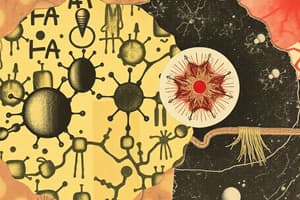Podcast
Questions and Answers
What is the main function of hemidesmosomes?
What is the main function of hemidesmosomes?
- Attach epithelial cells to the basement membrane (correct)
- Transport substances between cells
- Attach cells to each other
- Provide a watertight seal between cells
Tight junctions allow for the transport of ions and water between cells.
Tight junctions allow for the transport of ions and water between cells.
False (B)
What type of modification is responsible for providing cementing to keep neighboring cells together?
What type of modification is responsible for providing cementing to keep neighboring cells together?
Adherens junction
The __________ are channels that allow for the transport of ions, water, and other substances between neighboring cells.
The __________ are channels that allow for the transport of ions, water, and other substances between neighboring cells.
Match the following types of cell junctions with their function:
Match the following types of cell junctions with their function:
What is the primary function of cilia on epithelial cells?
What is the primary function of cilia on epithelial cells?
Flagella are short, hairlike structures that assist in the movement of material over epithelial surfaces.
Flagella are short, hairlike structures that assist in the movement of material over epithelial surfaces.
What are villi and why are they important for absorption?
What are villi and why are they important for absorption?
________ are temporary, irregular lobes formed by certain eukaryotic cells for motility and ingestion.
________ are temporary, irregular lobes formed by certain eukaryotic cells for motility and ingestion.
Match the following structures with their primary functions:
Match the following structures with their primary functions:
Which component is primarily responsible for the structure of plant cell walls?
Which component is primarily responsible for the structure of plant cell walls?
Microvilli are generally larger than villi and serve the same function.
Microvilli are generally larger than villi and serve the same function.
What are actin filaments primarily associated with in terms of cell structure?
What are actin filaments primarily associated with in terms of cell structure?
Flashcards are hidden until you start studying
Study Notes
Apical Modification
- Cilia: Short, hairlike projections found on the apical surface of epithelial cells, aiding in the movement of materials parallel to the epithelial surface, prominent in tracheal epithelial tissue.
- Flagella: Long, whip-like structures composed of microtubules found in bacteria and some eukaryotic cells, primarily responsible for locomotion; an example includes sperm cells.
- Villi and Microvilli:
- Villi: Finger-like projections that increase surface area for efficient absorption in certain organs.
- Microvilli: Smaller projections than villi, primarily enhance absorption efficiency of molecules, notably seen in the duodenum's columnar epithelium.
- Pseudopods: Temporary, irregular lobes formed by amoebas for movement and engulfing prey, consist mainly of actin filaments, occasionally containing microtubules and intermediate filaments.
- Extracellular Matrix (ECM): Secreted by cells, facilitating communication and attachment between nearby cells, crucial for cell functions like growth and movement. In plant cells, the cell wall made of cellulose distinguishes them from animal cells, forming fibers known as microfibrils.
Basal Modification
- Hemidesmosomes: Structures that anchor epithelial cells to the basement membrane, contributing to epithelial integrity and stability.
Lateral Modification
- Tight Junctions: Create a watertight seal between adjacent cells to prevent liquid leakage; vital in preventing urine from escaping the epithelial layer lining the bladder.
- Gap Junctions: Channels that enable the passage of ions, water, and other substances between neighboring cells, facilitating intercellular communication.
- Adherens/Adhering Junctions: Act as "cement" to hold neighboring cells together, reinforcing tissue structure and cohesion.
Studying That Suits You
Use AI to generate personalized quizzes and flashcards to suit your learning preferences.




